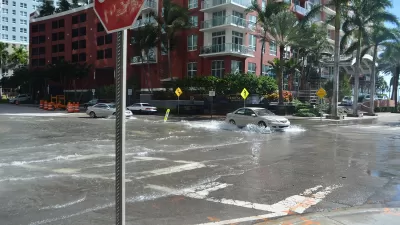South Miami, population 11,657, has had enough with the Florida legislature's intransigence at combatting climate change, so it has launched a secession movement for 24 southern counties to secede from the northern part of the state.
The City Commission of South Miami in Miami-Dade County, whose moniker is the City of Pleasant Living, passed a resolution on a 3-2 vote on Oct. 7 "in favor of splitting the state in half so South Florida would become the 51st state," writes
"Vice Mayor Walter Harris said he created the proposal because of growing frustration of northern Florida’s apathy on the effects of climate change in South Florida," writes Sarah Harvard of The Huffington Post.
"We have to be able to deal directly with this environmental concern and we can’t really get it done in Tallahassee," Harris said.
Mayor Philip Stoddard, who supported the resolution, was more illustrative in his explanation, according to Cutway.
“It’s very apparent that the attitude of the northern part of the state is that they would just love to saw the state in half and just let us float off into the Caribbean," Stoddard said.
There are, in fact, wide disparities in how the northern and southern parts of the state would stand up to sea level rise as the sixth "whereas" of the resolution indicates [PDF].
Whereas, the average elevation of the present state of Florida is approximately 100 feet above sea level. North Florida is approximately 120 feet above sea level while the average elevation of South Florida is less than 50 feet with a very large portion of South Florida averaging less than 15 feet above sea level. Many sections of South Florida are 5 feet or less above sea level, including Monroe County and the Gold Coast, consisting of Palm Beach County, Broward County and Miami-Dade County.
Last year we noted that "four South Florida counties have formed an alliance to figure out solutions," short of seceding to deal with rising sea level. However, in a separate post we noted that Miami may be the most 'indefensible' U.S. city to deal with that challenge.
The resolution now goes to the "governing bodies of the proposed South Florida counties for consideration," writes Cutway. See the second 'whereas':
Whereas, the new proposed state of South Florida would have 24 counties ("which counties shall herein after be referred to as "South Florida"). These 24 counties are 35% of the total number of counties in the current state of Florida and they would comprise approximately 23,000 square miles in area. Thus, South Florida would be comprised of 39% of the area of the current state of Florida and would have a population of approximately 13,375,000 people which is 67% of the total population of the current state of Florida...
Cutway closes by writing, "In order for secession to be enacted, however, the measure would require electorate approval from the entire state and Congressional approval." A tough road to hoe.
South Miami has also enacted its own climate mitigation measures, including using smart growth to reduce carbon emissions. Kaid Benfield of the Natural Resources Defense Council blogged last year (posted here) about how the South Miami Hometown district is a model for transitioning from auto-oriented suburban development to more sustainable and livable communities,
FULL STORY: Officials want South Florida to break off into its own state

Maui's Vacation Rental Debate Turns Ugly
Verbal attacks, misinformation campaigns and fistfights plague a high-stakes debate to convert thousands of vacation rentals into long-term housing.

Planetizen Federal Action Tracker
A weekly monitor of how Trump’s orders and actions are impacting planners and planning in America.

In Urban Planning, AI Prompting Could be the New Design Thinking
Creativity has long been key to great urban design. What if we see AI as our new creative partner?

King County Supportive Housing Program Offers Hope for Unhoused Residents
The county is taking a ‘Housing First’ approach that prioritizes getting people into housing, then offering wraparound supportive services.

Researchers Use AI to Get Clearer Picture of US Housing
Analysts are using artificial intelligence to supercharge their research by allowing them to comb through data faster. Though these AI tools can be error prone, they save time and housing researchers are optimistic about the future.

Making Shared Micromobility More Inclusive
Cities and shared mobility system operators can do more to include people with disabilities in planning and operations, per a new report.
Urban Design for Planners 1: Software Tools
This six-course series explores essential urban design concepts using open source software and equips planners with the tools they need to participate fully in the urban design process.
Planning for Universal Design
Learn the tools for implementing Universal Design in planning regulations.
planning NEXT
Appalachian Highlands Housing Partners
Mpact (founded as Rail~Volution)
City of Camden Redevelopment Agency
City of Astoria
City of Portland
City of Laramie





























